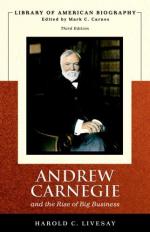
|
| Name: _________________________ | Period: ___________________ |
This quiz consists of 5 multiple choice and 5 short answer questions through Carnegie Challenges the World.
Multiple Choice Questions
1. William Coleman also shares Carnegie's interest and enthusiasm in what?
(a) Steel.
(b) Technology.
(c) Retail.
(d) Oil.
2. American capitalism and democracy conflict in the fear that economic justice requires what?
(a) An active interventionist role for government.
(b) No government.
(c) An inactive government.
(d) Small government.
3. Carnegie works ___________ years at the Pennsylvania Railroad while he develops managerial skill, economic principles and personal relationships to become a successful manager, capitalist and entrepreneur.
(a) Sixteen.
(b) Fourteen.
(c) Twelve.
(d) Eighteen.
4. Carnegie, acting under Scott-Thomson proxies, now owns how much of Pacific and Atlantic for the start-up Keystone Telegraph?
(a) One third.
(b) One eighth.
(c) One half.
(d) One fourth.
5. Carnegie corrects this deficiency by integrating _______________________.
(a) Sun Oil and US Oil.
(b) Keystone Bridge and Union Iron.
(c) Pennsylvania Railroad with Pacific Union.
(d) Pullman and Woodruff.
Short Answer Questions
1. In 1863, his investments pay $45,460 and by 1868, he receives __________ per year for an investment of $817 that he borrows to make.
2. A typical pattern in the ____________ century is that a community builds up around a few pioneers who leave their homeland and then encourage friends and relatives to join them.
3. Railroads need huge amounts of what to construct track and more as they expand?
4. Thirteen year-old Andrew sees his father fail while admiring whose determination to rise above it?
5. The Cyclops and Union Mills merger reduces time and labor cost of moving material and eliminates middlemen by _________ integration.
|
This section contains 236 words (approx. 1 page at 300 words per page) |

|




